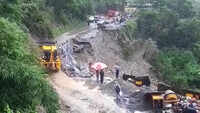
NEW DELHI: New Delhi: After 10 years of deliberations, demarcation of an eco-sensitive zone (ESZ) within the Western Ghats may finally happen before expiry of the fourth draft notification on September 26.
Once notified, all polluting activities will be prohibited within the earmarked zone.
The ecologically fragile Ghats spread over six states have so far not got the ESZ status due to objections mainly from Kerala, Karnataka and Maharashtra.
“All the efforts are being made to finalise the notification before that (September 26), taking into consideration the environmental concerns of the region while simultaneously addressing the need of the concerned states,” said Union environment secretary R P Gupta when asked about the fate of its final notification.
Covering a distance of 1,500 km along western coast, the Ghats is spread over Gujarat, Maharashtra, Goa, Karnataka, Kerala and Tamil Nadu.
Referring to prime reasons cited by states, Gupta said the high-level working group (that recommended various aspects of the eco-sensitive area within the Ghats) took into consideration the 2001 Census data while finalising its report, but ground realities have changed significantly during the last 19 years.
In order to address environmental concerns of the region, the ministry had constituted a Western Ghats ecology expert panel in March, 2010. After submission of its report in August 2011, the high-level working group (HLWG) under the chairmanship of K Kasturirangan was constituted in August, 2012 to examine the panel’s report in a holistic manner.
The HLWG, in its report submitted in April 2013, recommended that the activities which have "maximum interventionist and destructive impacts on natural ecosystems" should not be permitted in ESZ measuring 59,940 square km covering the six states.
The ministry had then issued its first draft notification to declare ESZ of the Ghats in March 2014, reducing the proposed eco-sensitive area from 59,940 square km to 56,825 square km.
In absence of a final decision, the ministry had then issued its second draft notification in September 2015, third in February 2017 and fourth in October 2018.
Once notified, all polluting activities will be prohibited within the earmarked zone.
The ecologically fragile Ghats spread over six states have so far not got the ESZ status due to objections mainly from Kerala, Karnataka and Maharashtra.
“All the efforts are being made to finalise the notification before that (September 26), taking into consideration the environmental concerns of the region while simultaneously addressing the need of the concerned states,” said Union environment secretary R P Gupta when asked about the fate of its final notification.
Covering a distance of 1,500 km along western coast, the Ghats is spread over Gujarat, Maharashtra, Goa, Karnataka, Kerala and Tamil Nadu.
Referring to prime reasons cited by states, Gupta said the high-level working group (that recommended various aspects of the eco-sensitive area within the Ghats) took into consideration the 2001 Census data while finalising its report, but ground realities have changed significantly during the last 19 years.
In order to address environmental concerns of the region, the ministry had constituted a Western Ghats ecology expert panel in March, 2010. After submission of its report in August 2011, the high-level working group (HLWG) under the chairmanship of K Kasturirangan was constituted in August, 2012 to examine the panel’s report in a holistic manner.
The HLWG, in its report submitted in April 2013, recommended that the activities which have "maximum interventionist and destructive impacts on natural ecosystems" should not be permitted in ESZ measuring 59,940 square km covering the six states.
The ministry had then issued its first draft notification to declare ESZ of the Ghats in March 2014, reducing the proposed eco-sensitive area from 59,940 square km to 56,825 square km.
In absence of a final decision, the ministry had then issued its second draft notification in September 2015, third in February 2017 and fourth in October 2018.
Download
The Times of India News App for Latest India News

Coronavirus outbreak
Trending Topics
LATEST VIDEOS
India
 Anti-Narcotics Cell seized huge cache of drugs, cash from house in Agartala, 1 arrested
Anti-Narcotics Cell seized huge cache of drugs, cash from house in Agartala, 1 arrested  If govt decides, Covid-19 vaccine's emergency authorisation could be considered: ICMR to parliamentary panel
If govt decides, Covid-19 vaccine's emergency authorisation could be considered: ICMR to parliamentary panel  Samsung names devices that will get 'three generations' of Android updates
Samsung names devices that will get 'three generations' of Android updates  Covid-19 crisis: 5 million salaried Indians lost their jobs in July
Covid-19 crisis: 5 million salaried Indians lost their jobs in July  Uttarakhand: Massive landslides on Mussoorie-Dehradun road, commuters stranded
Uttarakhand: Massive landslides on Mussoorie-Dehradun road, commuters stranded  Bhagat Singh Koshyari takes oath as governor of Goa
Bhagat Singh Koshyari takes oath as governor of Goa
More from TOI
Navbharat Times
Featured Today in Travel
Quick Links
Coronavirus in MumbaiCoronavirus in KolkataCoronavirus in HyderabadCoronavirus in DelhiCoronavirus in BangaloreCoronavirus symptomsCoronavirus in IndiaWhat is CoronavirusCoronavirus NewsSolar EclipseNPRWhat is NRCCAB BillCAB and NRCRTI BillPodcast newsLok SabhaShiv SenaYSRCPCongressBJP newsUIDAIIndian ArmyISRO newsSupreme Court
Get the app



